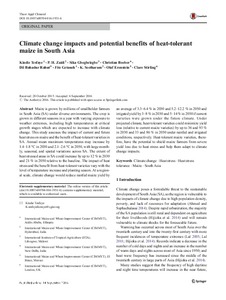| dc.contributor.author | Tesfaye, K. |
| dc.contributor.author | Zaidi, P.H. |
| dc.contributor.author | Gbegbelegbe, Sika |
| dc.contributor.author | Boeber, C. |
| dc.contributor.author | Rahut, D.B. |
| dc.contributor.author | Getaneh, F. |
| dc.contributor.author | Seetharam, K. |
| dc.contributor.author | Erenstein, Olaf |
| dc.contributor.author | Stirling, Clare M. |
| dc.date.accessioned | 2019-12-04T11:04:07Z |
| dc.date.available | 2019-12-04T11:04:07Z |
| dc.date.issued | 2016 |
| dc.identifier.citation | Tesfaye, K., Zaidi, P.H., Gbegbelegbe, S., Boeber, C., Rahut, D.B., Getaneh, F., ... & Stirling, C. (2016). Climate change impacts and potential benefits of heat-tolerant maize in South Asia. Theoretical and Applied Climatology, 1-12. |
| dc.identifier.issn | 0177-798X |
| dc.identifier.uri | https://hdl.handle.net/20.500.12478/1344 |
| dc.description | Article Purchased; Published online: 14 September 2016 |
| dc.description.abstract | Maize is grown by millions of smallholder farmers in South Asia (SA) under diverse environments. The crop is grown in different seasons in a year with varying exposure to weather extremes, including high temperatures at critical growth stages which are expected to increase with climate change. This study assesses the impact of current and future heat stress on maize and the benefit of heat-tolerant varieties in SA. Annual mean maximum temperatures may increase by 1.4–1.8 °C in 2030 and 2.1–2.6 °C in 2050, with large monthly, seasonal, and spatial variations across SA. The extent of heat stressed areas in SA could increase by up to 12 % in 2030 and 21 % in 2050 relative to the baseline. The impact of heat stress and the benefit from heat-tolerant varieties vary with the level of temperature increase and planting season. At a regional scale, climate change would reduce rainfed maize yield by an average of 3.3–6.4 % in 2030 and 5.2–12.2 % in 2050 and irrigated yield by 3–8 % in 2030 and 5–14 % in 2050 if current varieties were grown under the future climate. Under projected climate, heat-tolerant varieties could minimize yield loss (relative to current maize varieties) by up to 36 and 93 % in 2030 and 33 and 86 % in 2050 under rainfed and irrigated conditions, respectively. Heat-tolerant maize varieties, therefore, have the potential to shield maize farmers from severe yield loss due to heat stress and help them adapt to climate change impacts. |
| dc.description.sponsorship | Bill & Melinda Gates Foundation |
| dc.description.sponsorship | United States Agency for International Development |
| dc.format.extent | 1-12 |
| dc.language.iso | en |
| dc.subject | Climate Change |
| dc.subject | Heat Stress |
| dc.subject | Heat Tolerance |
| dc.subject | Maize |
| dc.subject | South Asia |
| dc.title | Climate change impacts and potential benefits of heat-tolerant maize in South Asia |
| dc.type | Journal Article |
| dc.description.version | Peer Review |
| cg.contributor.crp | Maize |
| cg.contributor.crp | Climate Change, Agriculture and Food Security |
| cg.contributor.affiliation | International Maize and Wheat Improvement Center |
| cg.contributor.affiliation | International Institute of Tropical Agriculture |
| cg.coverage.region | Asia |
| cg.coverage.region | South Asia |
| cg.coverage.country | Afghanistan |
| cg.coverage.country | Bangladesh |
| cg.coverage.country | Bhutan |
| cg.coverage.country | India |
| cg.coverage.country | Nepal |
| cg.coverage.country | Pakistan |
| cg.coverage.country | Sri Lanka |
| cg.isijournal | ISI Journal |
| cg.authorship.types | CGIAR multi-centre |
| cg.iitasubject | Climate Change |
| cg.iitasubject | Smallholder Farmers |
| cg.journal | Theoretical and Applied Climatology |
| cg.howpublished | Formally Published |
| cg.accessibilitystatus | Open Access |
| local.dspaceid | 79309 |
| cg.targetaudience | Scientists |
| cg.identifier.doi | https://dx.doi.org/10.1007/s00704-016-1931-6 |

